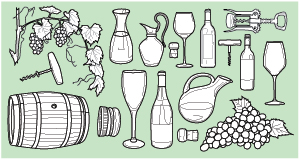Described by the Austrain Wine Marketing Board as the place of one of Austria's most traditional wines and the showpiece of Vienna's wine sector, Wiener Gemischter Satz becomes becomes Austria's ninth DAC designation of origin.
The first Wiener Gemischter Satz DAC wines to be released are from the 2013 vintage
The special feature of Wiener Gemischter Satz – the planting of different grape varieties side by side in one vineyard – was originally implemented long ago as a method for yield protection and minimizing risk. Because of the diversity of the varieties, which ripened at different times, the variations in their quantity and quality – based on the vintage - were relatively minor. Ultimately, a unique aroma and flavour profile developed, reflecting the special characteristics of the wine's origin.
The new regulations for the Wiener Gemischter Satz specify that at least three white quality grape varieties should be planted together in one Viennese vineyard and must be listed in the vineyard land registry as Wiener Gemischter Satz. In the wine, the share of one grape variety must be no more than 50%, while the share of the third variety must be at least 10%. The alcohol content – required on the label - can be no greater than 12.5% vol. The wine must be dry and should not have a strongly recognisable expression of wood.
The Wiener Gemischte Satz DAC can be marketed also with a single vineyard designation. The alcohol content of this wine must be a minimum of 12.5% vol. and indicated on the label. The wine does not have to match the ‘dry’ taste description, and it cannot be released for sale before March 1 of the year following the harvest.
The DAC applies exclusively to the regulations for the Wiener Gemischte Satz. This means that all other Viennese quality wines can be marketed under the designation of Wiener Wein (Viennese wine). Any Gemischter Satz that does not comply with the regulations for a Wiener Gemischter Satz must be marketed as a “Landwein” with the Weinland designation of origin.
“This special regulation was necessary for Viennese wine because Vienna is both the country's capital and a federal state - so until 2009, it was a wine region for Landwein as well as a wine growing area for quality wine,” said Willi Klinger, manager of the Austrian Wine Marketing Board. “The new DAC for the Wiener Gemischter Satz is a much more stringent guarantee of quality and origin than the previous regulation.”
Herbert Schilling, head of Vienna's regional wine committee, said: “With the Wiener Gemischter Satz DAC, we've achieved a milestone in the consistent, years-long quality policy for wine growing in Vienna. The new regulations sharpen the origin profile of Wiener Gemischter Satz and, at the same time, reflect Vienna's diversity in the glass.”




